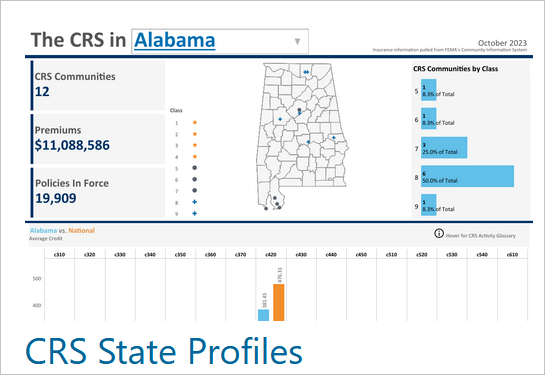- Home
- About Us
- Resources
- Events
- Members Only
- Contact Us
- Join Now
 Soft Solutions for Resiliency Reported by Rob Brown, Goodwyn Mills Cawood
As we continue our dive into resiliency, the focus if this article is “Soft Solutions.” There can be a number of approaches to strengthen preservation ordinances for buffers and floodplains that go beyond the state minimum standards like the use of designated conservation overlays or other zoning strategies; buyout programs for repetitive loss properties; participation in Community Rating System (CRS) Programs; and strengthening stormwater design requirements for redevelopment/infill.
There are a couple of programs within CRS that can be large contributors to points and resulting reductions in flood insurance premiums. These are “Higher Regulatory Standards” and “Open Space Preservation.” For higher regulatory standards, go to the ""Activity 430 Higher Regulatory Standards" section in the above link. Here you can see results by state for freeboard, building codes, higher building construction standards, floodplain use prohibitions, and other higher standards for you to see where your community fits and how you compare with your neighbors. Open space preservation targets land that is located in the Special Flood Hazard Area (SFHA), which is the FEMA regulatory 100-year floodplain. Additional credit is awarded through protecting these areas as open space and not developing within them. This can be accomplished through zoning strategies, enhanced buffer requirements, or land acquisition and conservation. Some coastal areas have begun to explore land use overlay districts as a tool to protect future marsh migration areas to mitigate flooding and improve CRS ratings since these areas are generally the current day floodplain (SFHA). One item associated with Higher Regulatory Standards is “Freeboard,” which is the additional elevation above the current 100-year floodplain, or base flood elevation (BFE), that buildings are required to be built to for their lowest finished first floor. Freeboard provides a margin of safety against more severe storms and increased future flood risks from the increased frequency of large storms everywhere and rising sea levels along the coast. In most floodplain ordinances, freeboard is generally applied to the SFHA only (e.g., A, AE, or VE flood zones). However, there are a few coastal communities, that have begun to add requirements to the “X 0.2%” flood zone (also referred to as the shaded X zone or 500-year floodplain) because with the addition of sea level rise or occurrence of larger storms, portions of these areas will eventually migrate to the SFHA. This includes Camden County, GA, as well as Hampton, and Norfolk, VA, which have specified to elevate the finished first floor elevation of a building to at least 1 or 1.5 feet above the highest adjacent grade at the building site. In addition, some communities have developed (and regulate to) a higher “local” or “future” floodplain that is developed by modeling the floodplain considering the impacts of future buildout, re-development, intensity of development, weather-related changes, etc. This also increases the freeboard above the FEMA SFHA. |

 One program we’d like to talk a little more about is the Community Rating System (CRS). CRS is a voluntary program associated with the FEMA National Floodplain Insurance Program (NFIP). While “floodplain” is in the name, there are many stormwater management activities that are credited under this program. Under CRS, communities accrue points for engaging in creditable activities and are rewarded for doing more than regulating construction of new buildings to the minimum national standards. In addition to the benefit of a more resilient community, ALL flood insurance policyholders in the community are rewarded with discounted flood insurance premiums ranging from a 5% to 45% discount. Nationwide, there are 1,505 communities that participate in this program, and more than one-third (531) are in our network, the Southeast!
One program we’d like to talk a little more about is the Community Rating System (CRS). CRS is a voluntary program associated with the FEMA National Floodplain Insurance Program (NFIP). While “floodplain” is in the name, there are many stormwater management activities that are credited under this program. Under CRS, communities accrue points for engaging in creditable activities and are rewarded for doing more than regulating construction of new buildings to the minimum national standards. In addition to the benefit of a more resilient community, ALL flood insurance policyholders in the community are rewarded with discounted flood insurance premiums ranging from a 5% to 45% discount. Nationwide, there are 1,505 communities that participate in this program, and more than one-third (531) are in our network, the Southeast! 